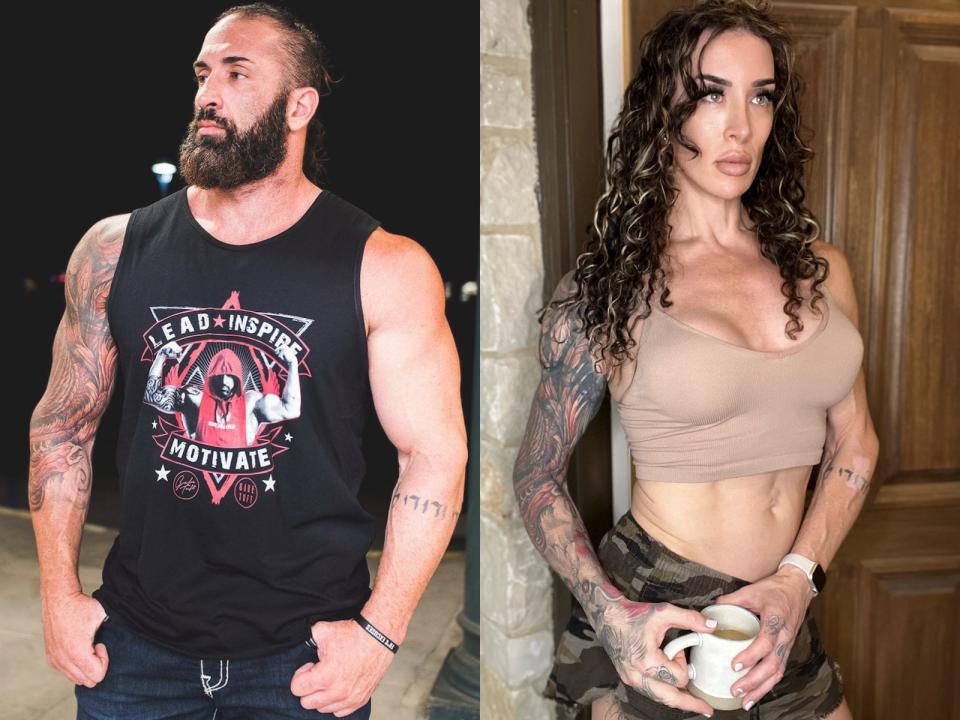Before my transition, I was a WWE star, weighed 280 pounds, and had 6% body fat. It took a lot of trial and error to get the feminine body I always wanted.

Before transitioning, I was a WWE star, weighed in at 280 pounds, and had 6% to 8% body fat.
To get the feminine body I dreamed of, I had to find the right diet and exercise for myself.
While I'm still evolving, I hope to pass what I've learned on to other trans people.
The transgender journey can be rife with internal questions about body image and external presentation. My own journey regularly sparks questions from others, given my position as a public — and extremely fit — athlete and fitness influencer.
One of the questions I often field is: "Gabbi, how did you lose all the muscle mass?" The answer isn't as straightforward as people may expect but is informed through 30 years in the fitness industry and my personal transition experience.
Every transition journey is unique. If you've known one transgender person, then you've heard about only one transgender person's journey. Mine was a study in evolving strength — inside and out.
When I started to transition, I was determined to get the body I always wanted
I chose to transition in my early 40s and grappled with doing so later in life. My body had been flooded with testosterone for many years. Coupled with my active, fitness-focused lifestyle and position as a WWE professional wrestler, I had built a large amount of muscle onto my frame. At 6-foot-2, I weighed in at 280 pounds and hovered at 6% to 8% body fat year-round. At my peak, I looked like a cross between Ragnar Lothbrok from "Vikings" and The Mountain from "Game of Thrones." This created quite a hurdle for me as I transitioned to female.
A common misconception is that estrogen and other hormone-replacement therapies cause large muscle masses to dissipate. The reality is that hormone therapy helps, but it's not the main factor in releasing a large amount of testosterone-borne muscle.
To lose the massive amount of muscle mass I had, I made myself a guinea pig. I combined my years of expertise in fitness and nutrition and got to work trying different nutrition styles and sustainable approaches to working out. I knew I could never be a person who didn't work out, but through research and data extrapolation, I knew I could find a pathway to the fit, feminine aesthetic I was after.
My research and experiments took two years, but I finally landed on a combination of fitness and nutrition that worked for me.
It was difficult, but I kept going to help other trans people
The 280-pound wrestler and bodybuilder that other people saw was not who I saw when I looked in the mirror. When I began my transition, I wrestled (no pun intended) with how I desired to present myself to the world.
No matter what, I knew there would be some awkward moments during the in-between. I described it as an "ugly-duckling phase" in a viral Instagram post. What kept me going through those in-between phases was the idea of being a lantern on the footpath for other transgender people.
I knew that if I shared what I had learned over several years of trial and error and research, and remained 100% authentic and honest, I could help others. That, in and of itself, made the more-trying times worthwhile. There is a level of empowerment to be found in discovering answers for yourself and passing on knowledge to others who can grow and thrive from that knowledge.
While I've achieved the body I wanted, I'm still evolving
I've lost 190 pounds of weight and muscle mass, but my transition didn't happen overnight. I sometimes felt discouraged, especially when what was staring back at me in the mirror didn't align with the image I had of myself in my head.
It's an evolutionary process, one that is not only physical and nutritional but also mental and emotional. I specialize in helping women break free of cyclical behaviors, and it's exactly what I needed to do when seeking to shed the muscle that defined my pretransition life.
I hope that my journey — and the work I have done in developing ways to stay fit while shedding pretransition muscle — will create a ripple effect within the trans community.
Gabbi Tuft is an online personal fitness and nutrition coach. She has coached over 1,500 clients to success over the past 13 years. She specializes in helping women break cyclical behavioral patterns for long-lasting, sustainable weight loss and physique changes. For more information, visit www.coachgabbi.com.
Read the original article on Insider


